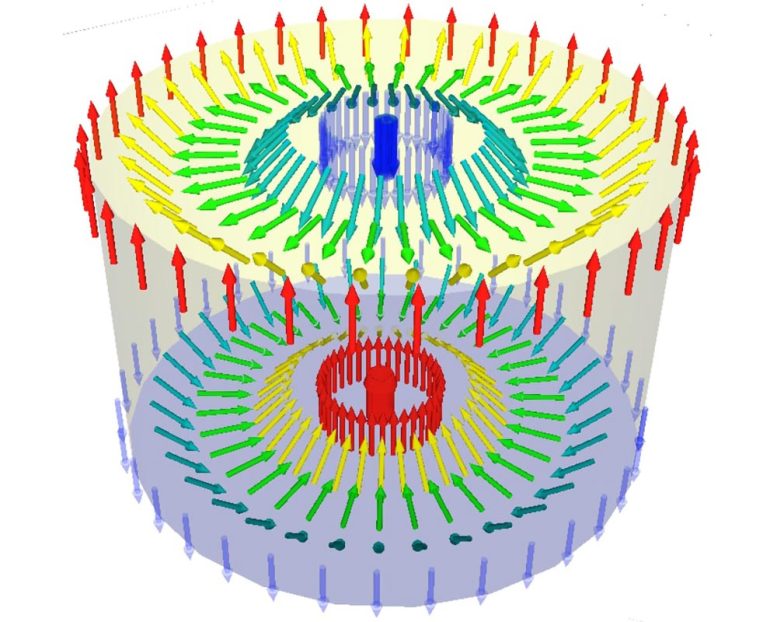Researchers in Germany and Japan have been able to increase the diffusion of magnetic whirls, so-called skyrmions, by a factor of ten.
In today’s world, our lives are unimaginable without computers. Up until now, these devices process information using primarily electrons as charge carriers, with the components themselves heating up significantly in the process. Active cooling is thus necessary, which comes with high energy costs. Spintronics aims to solve this problem: Instead of utilizing the electron flow for information processing, it relies on their spin or their intrinsic angular momentum. This approach is expected to have a positive impact on the size, speed, and sustainability of computers or specific components.
Magnetic Whirls Store and Process Information
Science often does not simply consider the spin of an individual electron, but rather magnetic whirls composed of numerous spins. These whirls called skyrmions emerge in magnetic metallic thin layers and can be considered as two-dimensional quasi-particles. On the one hand, the whirls can be deliberately moved by applying a small electric current to the thin layers; on the other hand, they move randomly and extremely efficiently due to diffusion. The feasibility of creating a functional computer based on skyrmions was demonstrated by a team of researchers from Johannes Gutenberg University Mainz (JGU), led by Professor Dr. Mathias Kläui, using an initial prototype. This prototype consisted of thin, stacked metallic layers, some only a few atomic layers thick.

Two skyrmions antiferromagnetically coupled: The spin in the center and the outside spins are antiparallel to each other. Credit: ill./©: Takaaki Dohi / Tohoku University
Boosting Energy Efficiency
In collaboration with the University of Konstanz and Tohoku University in Japan, researchers of Mainz University have now achieved another step towards spin-based, unconventional computing: They were able to increase the diffusion of skyrmions by a factor of about ten using synthetic antiferromagnets, which drastically reduces the energy consumption and increases the speed of such a potential computer. “The reduction of energy usage in electronic devices is one of the biggest challenges in fundamental research,” emphasized Professor Dr. Ulrich Nowak, who led the theoretical part of the project in Konstanz.
The Power of Antiferromagnets
But what is an antiferromagnet and what is it used for? Normal ferromagnets consist of many small spins, all coupled together to point in the same direction, thereby creating a large magnetic moment. In antiferromagnets, the spins are aligned alternatingly antiparallel, i.e., a spin and its direct neighbors point in the opposite direction. As a result, there is no net magnetic moment, even though the spins remain antiferromagnetically well-ordered. Antiferromagnets have significant advantages, such as three magnitudes of faster dynamics for switching, better stability, and the potential for higher storage densities. These properties are intensively studied in multiple research projects.
In order to understand why these antiferromagnets are useful in this context, we need to delve a bit deeper. When skyrmions move very rapidly, an additional force component arises in ferromagnetic layers perpendicular to the direction of motion. This force component pushes the skyrmions off course. Consequently, they end up colliding with the wall, getting stuck, and obstructing the path for others. At higher speeds, they can even be destroyed. However, it is theoretically known that this effect either does not occur in antiferromagnets or it occurs to a very limited extent.
Advancements in Synthetic Antiferromagnets
To create such an antiferromagnet artificially, the researchers coupled two of their ferromagnetic layers in a way that the magnetization in the two layers is precisely aligned in opposite directions, canceling out their magnetic fields. This provides two advantages: They reduce the force pushing the whirls off their path and thus increase the diffusion. “With this, we have created a synthetic antiferromagnet in which the diffusion of skyrmions is approximately ten times higher than in the individual layers,” said Klaus Raab, a physicist at JGU. “This diffusion can be implemented to realize stochastic computing – a form of computing where stochastic processes like the random motion of particles are utilized.”
The team of researchers investigated the effects of the compensation of the magnetic layers in addition to the influence of temperature and size of the skyrmions on diffusion and consequently on the motion of the skyrmions, both experimentally and through simulations. Intricate connections have been found: As temperature rises, the skyrmions have more energy to diffuse faster. The heat also reduces the size of the skyrmions, which positively affects their mobility. The compensation of the vertical force component also has a positive impact on diffusion. All these effects are difficult to disentangle from each other. “The increasing diffusion seems to be attributable not only to the pure compensation of the magnetic fields but also to the associated reduction in the size of the skyrmions,” summarized Raab.
Professor Mathias Kläui, who led the study, is pleased with the fruitful collaboration with Tohoku University: “We have been working with this leading Japanese university for about ten years and there are even joint study programs. With the support of the German Academic Exchange Service – the DAAD – and other research funders, over a dozen students from Mainz University have already participated in exchanges with Tohoku University. I am delighted that this collaborative effort has been made possible through this cooperation.”
The research results have been published recently in the journal Nature Communications.
Reference: “Enhanced thermally-activated skyrmion diffusion with tunable effective gyrotropic force” by Takaaki Dohi, Markus Weißenhofer, Nico Kerber, Fabian Kammerbauer, Yuqing Ge, Klaus Raab, Jakub Zázvorka, Maria-Andromachi Syskaki, Aga Shahee, Moritz Ruhwedel, Tobias Böttcher, Philipp Pirro, Gerhard Jakob, Ulrich Nowak and Mathias Kläui, 11 September 2023, Nature Communications.
DOI: 10.1038/s41467-023-40720-0
News
Enhanced Antibacterial Polylactic Acid-Curcumin Nanofibers for Wound Dressing
Background Wound healing is a complex physiological process that can be compromised by infection and impaired tissue regeneration. Conventional dressings, typically made from natural fibers such as cotton or linen, offer limited functionality. Nanofiber [...]
Global Nanomaterial Regulation: A Country-by-Country Comparison
Nanomaterials are materials with at least one dimension smaller than 100 nanometres (about 100,000 times thinner than a human hair). Because of their tiny size, they have unique properties that can be useful in [...]
Pandemic Potential: Scientists Discover 3 Hotspots of Deadly Emerging Disease in the US
Virginia Tech researchers discovered six new rodent carriers of hantavirus and identified U.S. hotspots, highlighting the virus’s adaptability and the impact of climate and ecology on its spread. Hantavirus recently drew public attention following reports [...]
Studies detail high rates of long COVID among healthcare, dental workers
Researchers have estimated approximately 8% of Americas have ever experienced long COVID, or lasting symptoms, following an acute COVID-19 infection. Now two recent international studies suggest that the percentage is much higher among healthcare workers [...]
Melting Arctic Ice May Unleash Ancient Deadly Diseases, Scientists Warn
Melting Arctic ice increases human and animal interactions, raising the risk of infectious disease spread. Researchers urge early intervention and surveillance. Climate change is opening new pathways for the spread of infectious diseases such [...]
Scientists May Have Found a Secret Weapon To Stop Pancreatic Cancer Before It Starts
Researchers at Cold Spring Harbor Laboratory have found that blocking the FGFR2 and EGFR genes can stop early-stage pancreatic cancer from progressing, offering a promising path toward prevention. Pancreatic cancer is expected to become [...]
Breakthrough Drug Restores Vision: Researchers Successfully Reverse Retinal Damage
Blocking the PROX1 protein allowed KAIST researchers to regenerate damaged retinas and restore vision in mice. Vision is one of the most important human senses, yet more than 300 million people around the world are at [...]
Differentiating cancerous and healthy cells through motion analysis
Researchers from Tokyo Metropolitan University have found that the motion of unlabeled cells can be used to tell whether they are cancerous or healthy. They observed malignant fibrosarcoma [...]
This Tiny Cellular Gate Could Be the Key to Curing Cancer – And Regrowing Hair
After more than five decades of mystery, scientists have finally unveiled the detailed structure and function of a long-theorized molecular machine in our mitochondria — the mitochondrial pyruvate carrier. This microscopic gatekeeper controls how [...]
Unlocking Vision’s Secrets: Researchers Reveal 3D Structure of Key Eye Protein
Researchers have uncovered the 3D structure of RBP3, a key protein in vision, revealing how it transports retinoids and fatty acids and how its dysfunction may lead to retinal diseases. Proteins play a critical [...]
5 Key Facts About Nanoplastics and How They Affect the Human Body
Nanoplastics are typically defined as plastic particles smaller than 1000 nanometers. These particles are increasingly being detected in human tissues: they can bypass biological barriers, accumulate in organs, and may influence health in ways [...]
Measles Is Back: Doctors Warn of Dangerous Surge Across the U.S.
Parents are encouraged to contact their pediatrician if their child has been exposed to measles or is showing symptoms. Pediatric infectious disease experts are emphasizing the critical importance of measles vaccination, as the highly [...]
AI at the Speed of Light: How Silicon Photonics Are Reinventing Hardware
A cutting-edge AI acceleration platform powered by light rather than electricity could revolutionize how AI is trained and deployed. Using photonic integrated circuits made from advanced III-V semiconductors, researchers have developed a system that vastly [...]
A Grain of Brain, 523 Million Synapses, Most Complicated Neuroscience Experiment Ever Attempted
A team of over 150 scientists has achieved what once seemed impossible: a complete wiring and activity map of a tiny section of a mammalian brain. This feat, part of the MICrONS Project, rivals [...]
The Secret “Radar” Bacteria Use To Outsmart Their Enemies
A chemical radar allows bacteria to sense and eliminate predators. Investigating how microorganisms communicate deepens our understanding of the complex ecological interactions that shape our environment is an area of key focus for the [...]
Psychologists explore ethical issues associated with human-AI relationships
It's becoming increasingly commonplace for people to develop intimate, long-term relationships with artificial intelligence (AI) technologies. At their extreme, people have "married" their AI companions in non-legally binding ceremonies, and at least two people [...]





















